Showing Spotlights 913 - 920 of 2878 in category All (newest first):
 Research groups around the world are taking big strides towards developing ultrathin and flexible sensor devices that could be attached to the skin, or even organs, and monitor vital body functions. However, the adhesion to skin of many of these sensor patches is weak. A new milestone study on skin adhesives for wearable devices is about to change that. It demonstrates that it is possible to strongly and non-invasively attach soft wearable sensors and other devices to dry or wet skin.
Research groups around the world are taking big strides towards developing ultrathin and flexible sensor devices that could be attached to the skin, or even organs, and monitor vital body functions. However, the adhesion to skin of many of these sensor patches is weak. A new milestone study on skin adhesives for wearable devices is about to change that. It demonstrates that it is possible to strongly and non-invasively attach soft wearable sensors and other devices to dry or wet skin.
Jun 1st, 2017
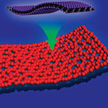 In new work, a research team has developed a general synthesis strategy by employing graphene oxide as a sacrificial template to prepare various 2D holey transition metal oxide (TMO) nanosheets, including mixed metal oxides and simple metal oxides. This approach is universal for the synthesis of various 2D holey TMO nanosheets including mixed transition-metal oxides and simple oxides. This unique holey structure can minimize the restacking of 2D nanosheets and provide more active sites for alkali-ion storage.
In new work, a research team has developed a general synthesis strategy by employing graphene oxide as a sacrificial template to prepare various 2D holey transition metal oxide (TMO) nanosheets, including mixed metal oxides and simple metal oxides. This approach is universal for the synthesis of various 2D holey TMO nanosheets including mixed transition-metal oxides and simple oxides. This unique holey structure can minimize the restacking of 2D nanosheets and provide more active sites for alkali-ion storage.
May 31st, 2017
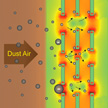 Researchers have utilized a rotating triboelectric nanogenerator (R-TENG) to enhance a polyimide nanofiber air filter for particulate matter (PM) removal. The nanofiber filter exhibits high removal efficiency for the PM particles with diameter larger than 0.5 microns. When working with the R-TENG, the removal efficiency of the filter is enhanced, especially in the region with the diameter of the particles in the PM smaller than 100 nm. This work may propose an approach of air cleaning and haze management by introducing TENGs to the filters.
Researchers have utilized a rotating triboelectric nanogenerator (R-TENG) to enhance a polyimide nanofiber air filter for particulate matter (PM) removal. The nanofiber filter exhibits high removal efficiency for the PM particles with diameter larger than 0.5 microns. When working with the R-TENG, the removal efficiency of the filter is enhanced, especially in the region with the diameter of the particles in the PM smaller than 100 nm. This work may propose an approach of air cleaning and haze management by introducing TENGs to the filters.
May 26th, 2017
 Inspired by octopus arms, researchers demonstrate an uncomplicated and scalable templating technology for fabricating nanosuckers on PDMS substrates, using a scalable spin-coating technology. As the nanosuckers are pressed against a substrate, the flexible nanosuckers confirm to the substrate and deform by releasing the internal air between nanosuckers and the substrate, forming a seal and generating an adhesion force. The nanosucker adhesion is maintained over multiple contact cycles on both wet and dry surfaces.
Inspired by octopus arms, researchers demonstrate an uncomplicated and scalable templating technology for fabricating nanosuckers on PDMS substrates, using a scalable spin-coating technology. As the nanosuckers are pressed against a substrate, the flexible nanosuckers confirm to the substrate and deform by releasing the internal air between nanosuckers and the substrate, forming a seal and generating an adhesion force. The nanosucker adhesion is maintained over multiple contact cycles on both wet and dry surfaces.
May 25th, 2017
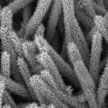 The development of porous one-dimensional (1D) nanomaterials with designed properties and architectures has led to significant advances in electrochemical energy storage. A recent review article highlights the state-of-the-art on porous 1D nanostructures, from methodologies for rational and controllable synthesis (electrospinning, liquid phase method, template-assisted method, chemical deposition method, and chemical etching) to their successful application in different types of energy storage devices.
The development of porous one-dimensional (1D) nanomaterials with designed properties and architectures has led to significant advances in electrochemical energy storage. A recent review article highlights the state-of-the-art on porous 1D nanostructures, from methodologies for rational and controllable synthesis (electrospinning, liquid phase method, template-assisted method, chemical deposition method, and chemical etching) to their successful application in different types of energy storage devices.
May 24th, 2017
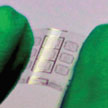 Inspired by the unique optical and electronic property of graphene, two-dimensional layered materials - as well as their hybrids - have been intensively investigated in recent years, driven by their potential applications for nanoelectronics. The broad spectrum of atomic layered crystals includes transition metal dichalcogenides (TMDs), semiconducting dichalcogenides, monoatomic buckled crystals, such as black phosphorous (BP), and diatomic hexagonal boron nitride, etc. Tihis article examines the recent advancement of flexible 2D electronic devices based on TMDs and BP.
Inspired by the unique optical and electronic property of graphene, two-dimensional layered materials - as well as their hybrids - have been intensively investigated in recent years, driven by their potential applications for nanoelectronics. The broad spectrum of atomic layered crystals includes transition metal dichalcogenides (TMDs), semiconducting dichalcogenides, monoatomic buckled crystals, such as black phosphorous (BP), and diatomic hexagonal boron nitride, etc. Tihis article examines the recent advancement of flexible 2D electronic devices based on TMDs and BP.
May 23rd, 2017
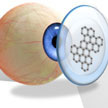 Several research projects are working on reinventing the contact lens as a smart electronic device that, for instance, works as a self-powered biosensor for various point-of-care monitoring and wireless biomedical sensing. n addition to sensors, researchers are devising numerous applications for smart contact lenses, ranging from drug delivery systems to protection from electromagnetic wave damage. An application closer to contact lenses' original function, graphene can change the focal length of a polymeric soft contact lens in order to adjust near- and farsightedness.
Several research projects are working on reinventing the contact lens as a smart electronic device that, for instance, works as a self-powered biosensor for various point-of-care monitoring and wireless biomedical sensing. n addition to sensors, researchers are devising numerous applications for smart contact lenses, ranging from drug delivery systems to protection from electromagnetic wave damage. An application closer to contact lenses' original function, graphene can change the focal length of a polymeric soft contact lens in order to adjust near- and farsightedness.
May 22nd, 2017
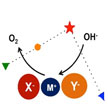 Researchers have proposed and proved an innovative strategy of anionic regulation. The construction of active sites with intrinsic oxygen evolution reaction (OER) is of great significance to overcome the limited efficiency of abundant sustainable energy devices such as fuel cells, rechargeable metal-air batteries, and in water splitting. Anionic regulation of electrocatalysts by modulating the electronic structure of active sites significantly promotes OER performance.
Researchers have proposed and proved an innovative strategy of anionic regulation. The construction of active sites with intrinsic oxygen evolution reaction (OER) is of great significance to overcome the limited efficiency of abundant sustainable energy devices such as fuel cells, rechargeable metal-air batteries, and in water splitting. Anionic regulation of electrocatalysts by modulating the electronic structure of active sites significantly promotes OER performance.
May 18th, 2017
 Research groups around the world are taking big strides towards developing ultrathin and flexible sensor devices that could be attached to the skin, or even organs, and monitor vital body functions. However, the adhesion to skin of many of these sensor patches is weak. A new milestone study on skin adhesives for wearable devices is about to change that. It demonstrates that it is possible to strongly and non-invasively attach soft wearable sensors and other devices to dry or wet skin.
Research groups around the world are taking big strides towards developing ultrathin and flexible sensor devices that could be attached to the skin, or even organs, and monitor vital body functions. However, the adhesion to skin of many of these sensor patches is weak. A new milestone study on skin adhesives for wearable devices is about to change that. It demonstrates that it is possible to strongly and non-invasively attach soft wearable sensors and other devices to dry or wet skin.
 Subscribe to our Nanotechnology Spotlight feed
Subscribe to our Nanotechnology Spotlight feed





